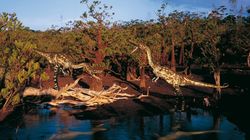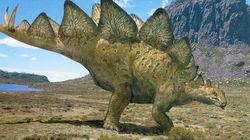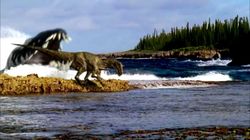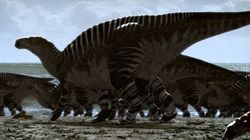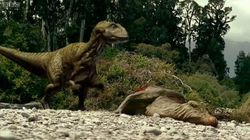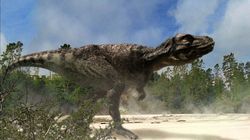Walking with DinosaursDinoszauruszok - A Föld urai

Befejezett / kaszált 1999.10 - 1999.11 | 60 perc @BBC One , GB
Alkotó: Tim Haines
Galéria
Kenneth Branagh (Narrator)
Természet, Történelmi, Science Fiction, Dokumentum, Animációs
Honlap | IMDb | SorozatJunkie | TV Maze | TMDB
10.04.
21:00
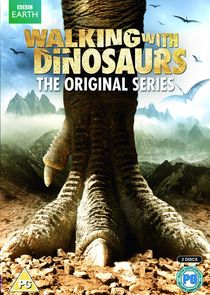
Epizód adatlap | SorozatJunkie | IMDb | Hozzászólások (0) |
220 million years ago, Late Triassic (Arizona)Filming location: New Caledonia
A female Coelophysis is shown stalking a herd of dicynodonts called Placerias (a giant synapsid or mammal-like reptile), looking for weak members to prey upon. A male Thrinaxodon is shown downstream, returning to his burrow from the river. The last focus of the episode is a female rauisuchian Postosuchus (one of the largest carnivores alive in the Triassic) who is first shown attacking a Placeriasherd and bites one of the members, driving the rest of the herd to retreat and leave the wounded and weakened member of the group to the carnivore. Early pterosaurs called Peteinosaurus are depicted feeding on dragonflies and cooling themselves in what little water is present during the drought. Still searching for food, the Coelophysis are shown discovering the Thrinaxodon burrow (and are initially frightened away by the male when it emerges). Eventually, an inquisitive Thrinaxodon pup follows the father to the entrance and is eaten by the female Ceolophysis before he can drive the predator away. At night, the pair of Thrinaxodon are shown eating their remaining young, then moving away, while during the day, the Coelophysis work to expose the nest.
The female Postosuchus is later shown to have been wounded by the Placerias in a previous attack (which left her with a tusk wound on her thigh), and after being unable to successfully hunt another member of the Placerias herd she is beaten out of her territory by a rival male Postosuchus. Wounded, sick and without a territory, the female dies and is eaten by a pack of Coelophysis. As the dry season continues however, food becomes scarce and extreme measures are taken by all animals. The Placerias herd embarks on a trek through parched wasteland in search of water, while the Coelophysis start killing and cannibalising their young. The male Thrinaxodon also resorts to hunting baby Coelophysis during the night. Finally, the wet season comes, and the majority of theCoelophysis have survived (including the female), along with the Thrinaxodon pair, who have a new clutch of eggs. The episode ends with the arrival of a migrating herd of the prosauropod Plateosaurus, foreshadowing the future dominance of the giant sauropods after the Triassic-Jurassic extinction event.
Animals Coelophysis · Thrinaxodon (identified as Cynodont) · Placerias · Postosuchus · Peteinosaurus · Plateosaurus · Lungfish ·Dragonflies
10.11.
21:00

Epizód adatlap | SorozatJunkie | IMDb | Hozzászólások (0) |
152 million years ago, Late Jurassic (Colorado)Filming location: California State Parks, Chile, Tasmania, New Zealand
This episode follows the life of a young female herbivorous sauropod Diplodocus beginning at the moment when her mother lays a clutch of eggs at the edge of a conifer forest. Months later, some of the eggs hatch and the young sauropods are preyed upon by Ornitholestes. After hatching, the young female and her siblings retreat to the safety of the denser trees. As they grow, they face many dangers, including repeated predation by Ornitholestes and Allosaurus. Even the herbivorous Stegosaurus accidentally kills one of her siblings while swinging its tail.
In parallel, adult herds of Diplodocus are depicted as titanic eating machines that use their massive weight to topple trees in order to get at the leaves of cycads in between trunks. The Diplodocus are also shown to host their own small mobile habitats that include damselflies, Anurognathus and dung beetles.
Close to adulthood, the creche of five-year-old Diplodocus grow to 13 meters and are nearly all killed by a huge forest fire (made worse by a firestorm in the night). In the end only three, then two, survivors including the female make it onto the open plains, where they encounter several Brachiosaurus · , before finding an adult Diplodocus herd and safety. Years later, the protagonist female mates, but not long afterwards is attacked by a bull Allosaurus. She is saved when another Diplodocus strikes the Allosaurus with its tail. She rejoins the herd but with a deep wound. In the end it is commented that her kind will only get bigger and that when the sauropods die out, life will never again be this large. In the DVD release, most of the narration from the original broadcast is missing.
Animals Diplodocus · Allosaurus · Ornitholestes · Stegosaurus · Brachiosaurus · Anurognathus · Dryosaurus · Othnielia · Dung Beetle
10.18.
21:00

Epizód adatlap | SorozatJunkie | IMDb | Hozzászólások (0) |
149 million years ago, Late Jurassic (Oxfordshire) Filming location: The Bahamas, New Caledonia
The episode begins with a Eustreptospondylus being snatched from the shore by the pliosaurLiopleurodon. Meanwhile, the ichthyosaur Ophthalmosaurus live-breeding ceremony is the main event taking place, as hundreds of Ophthalmosaurus arrive from the open ocean to give birth. In the midst of the birthing sharks and other predators, including Liopleurodon, are on the hunt, and when one mother has trouble giving birth, a pair of Hybodus sharks go after her, but are frightened off by a male Liopleurodon, which eats the front half of the Ophthalmosaurus, leaving the tail to sink down and be feasted upon by the Hybodus. Meanwhile aEustreptospondylus swims to an island and discovers a turtle carcass that it must contend for with another Eustreptospondylus. Later during the night, a group of horseshoe crabs gather at the shore to lay their eggs, which attracts a flock of Rhamphorhynchus in the morning to eat the eggs. However a few of the pterosaurs are caught and eaten by a Eustreptospondylus. While the Ophthalmosaurus juveniles are growing up, they are still hunted by Hybodus, which in turn, are prey for the Liopleurodon. At one point, while the male Liopleurodon is hunting for prey, he is encountered by a female Liopleurodon. After the male bites one of her flippers, she retires from his territory, followed by a group of Hybodus catching her trail of blood. A typhoon then strikes the islands, and kills many animals, including severalRhamphorhynchus. The Liopleurodon himself is washed ashore and lays upon the beach, eventually suffocating under his own weight. The carcass then becomes the banquet of a group of hovering Eustreptospondylus. At the end of the episode, the juvenileOphthalmosaurus that survived the storm are now large enough to swim off to live and breed in the open sea.
Animals Ophthalmosaurus · Liopleurodon · Eustreptospondylus · Cryptoclidus · Rhamphorhynchus · Hybodus (identified as shark) ·Perisphinctes (identified as ammonite) · Leptolepis · Horseshoe crab · Squid · Turtle (carcass) · Jellyfish · Fish · Coral
10.25.
21:00

Epizód adatlap | SorozatJunkie | IMDb | Hozzászólások (0) |
127 million years ago, Early Cretaceous (Brazil, North America, Europe and Cantabria)
Filming location: New Zealand, Tasmania
The story begins with a male Tropeognathus (identified simply as Ornithocheirus) dead on a beach. It then goes back six months to Brazil, where the Tropeognathus, resting among a colony of breeding Tapejara flies off for Cantabria where he too must mate. He flies past amigrating column of iguanodont Dakotadon and a Polacanthus (all herbivorous dinosaurs). He reaches the southern tip of North America, where he is forced to shelter from a storm. To pass the time, he grooms himself, expelling his body of Saurophthirus fleas while his beak's display crest begins to show color changes in readiness for mating. He then sets off across the Atlantic(which was then only 300 kilometers wide) and after a whole day on the wing, reaches the westernmost of the European islands. He does not rest there however, as a pack ofUtahraptors are hunting Iguanodon - one attack fails, but another assault succeeds and a young Utahraptor is bullied off the carcass by the adults after trying its luck. The Tropeognathus flies to the outskirts of a forest to rest, but is driven away by Iberomesornis birds. Flying on, he reaches Cantabria, but due to the delays and his exhaustion he cannot reach the center of the many grounded male Tropeognathus and consequently he does not mate. After days under the sun trying to attract a mate, the protagonist Tropeognathus dies from heat exhaustion and starvation alongside others who also lost out. Nature however is seldom wasteful, their corpses are yielded as food by the next generation.
Animals Tropeognathus (identified as Ornithocheirus) · Utahraptor · Dakotadon (identified as North American Iguanodon) ·Iguanodon · Tapejara · Polacanthus · Iberomesornis (identified as bird) · Plesiopleurodon (unidentified) · Saurophthirus · unidentified crested Pterosaurs · Fish
11.01.
21:00

Epizód adatlap | SorozatJunkie | IMDb | Hozzászólások (0) |
106 million years ago, Middle Cretaceous (Antarctica/Australia)
Filming location: New Zealand
A few hundred kilometres from the South Pole, a clan of herbivorous Leaellynasaura are seen emerging to activity after months of total darkness. Now with the coming of spring, the members of the clan are shown feeding on the fresh plant growth and building nests so they can lay their eggs. A male amphibian Koolasuchus has also woken up from hibernation and heads to a river where he will stay during the summer. Out on the rocky river banks, migrating herds of herbivorous Muttaburrasaurus have arrived to feed on the fresh vegetation and lay their eggs, also dealing with blood-sucking insects. By summer, many of the Leaellynasaura clan's eggs have been eaten, but those of the matriarch hatch successfully. A male polar allosaur is shown hunting the Leaellynasaura and Muttaburrasaurus. The Leaellynasaura clan continues to prepare for the winter, as well as raising the young that have now grown. When autumn arrives, the Muttaburrasaurus herd begins to head back north, and the Koolasuchus leaves the river to find a pool in the forest to hibernate through the winter. However, during the migration some Muttaburrasaurus become lost in the forest and the noise they make in the process of trying to get back to the herd prevents the Leaellynasaura clan's sentry from hearing the polar allosaur approaching. In the confusion, the allosaur manages to catch and kill the matriarch of the Leaellynasaura clan, while only one of the hatchlings survives the year. After the last day passes in a matter of minutes, winter descends and the forest becomes almost completely darkened, requiring image enhancement to the camera to view what wildlife are still active. The Leaellynasaura clan is able to stay active despite their social order being in disarray, using their large eyes to help them forage for food. During this time, the clan and other fauna use various methods of dealing with the cold, including suspended animation, hibernation or using group body temperature to maintain heat. Finally, spring returns, and two Leaellynasaura males challenge one another for the right to mate, and after a short confrontation, the clan establishes a dominant pair once again.
In the end it is accepted that the shifting of the continents will soon pull the landmass closer to the South Pole, and that the forests, and all these unique dinosaurs will soon disappear.
Animals Leaellynasaura · Koolasuchus · Polar allosaur (likely Australovenator) · Muttaburrasaurus · Steropodon (identified as Mammal) · Giant Weta · Tuatara · unidentified pterosaurs · blood-sucking insects
11.08.
21:00

Epizód adatlap | SorozatJunkie | IMDb | Hozzászólások (0) |
65.5 million years ago, Late Cretaceous (Montana)
Filming location: Chile, New Zealand
This episode starts months before the extinction of the dinosaurs. The last dinosaurs are depicted living under intense environmental stress due to excessive volcanism. Many of the dinosaur and pterosaur species still in existence are the largest and most developed of their respective genera, including Ankylosaurus, Quetzalcoatlus, Triceratops and Tyrannosaurus. The story focuses on a female Tyrannosaurus who abandons her nest, the eggs rendered infertile due to volcanic poisoning. Her calls for a mate are answered by a smaller male who kills a young Triceratops to appease her. Three days later, after repeated copulation and theTriceratops carcass being stripped, she eventually drives him off. The mother fasts for an extended period as she tends to her nest, dealing with raids by Dromaeosaurus and marsupialDidelphodons. As the female tends to her vigil, herds of the hadrosaur Edmontosaurus wander from islands of vegetation among fields of volcanic ash, while Torosaurus rut for the right to mate and lose their young to attackingDromaeosaurus. Meanwhile, the mother Tyrannosaurus sees only three of her twelve eggs hatch and brings down an Edmontosaurusto feed herself and her brood. While defending her two surviving offspring several days later, the mother is fatally injured by anAnkylosaurus who swings its clubbed tail at her right side; the blow cracks her femur and ruptures internal organs. The chicks remain expectantly next to the carcass of their mother the next morning until they, and the rest of the non-avian dinosaurs in this region, are killed when an asteroid slams into the Earth, a catastrophe that triggers the Cretaceous–Paleogene extinction event. A final short sequence shows the African plains on the present-day Earth, dominated by the large African mammals of today, but still populated with numerous forms of dinosaurs: the birds.
Animals Tyrannosaurus · Edmontosaurus (identified as Anatotitan) · Ankylosaurus · Deinosuchus · Didelphodon ·Dinilysia · Dromaeosaurus · Quetzalcoatlus · Torosaurus · Triceratops (carcass) · unidentified Hypsilophodont
